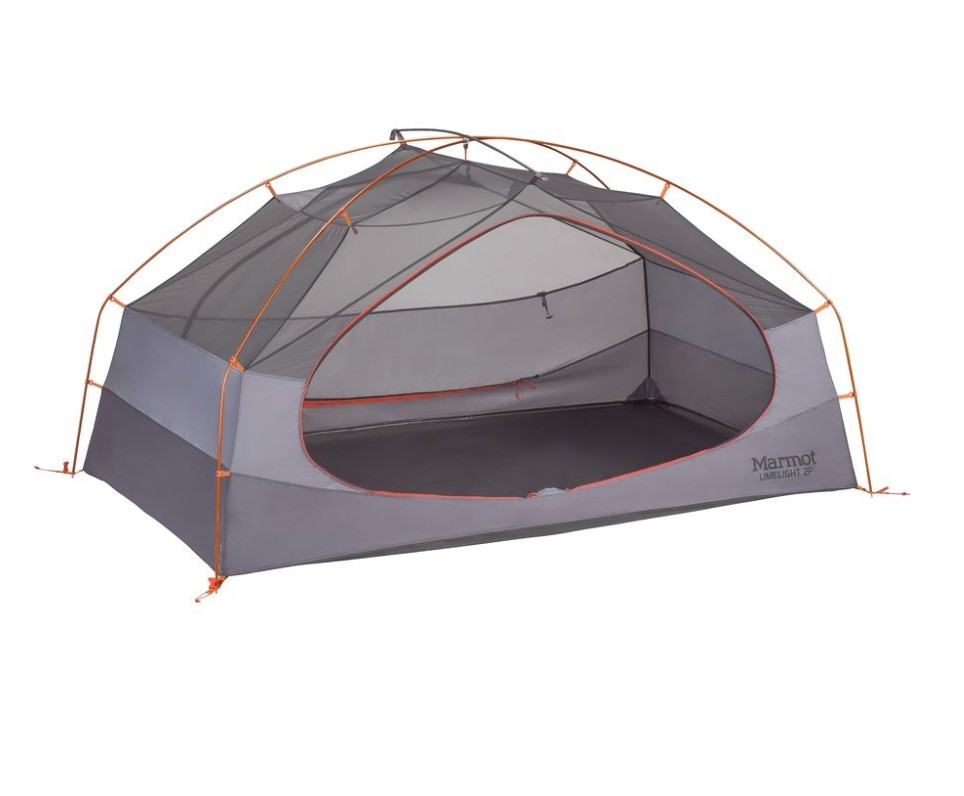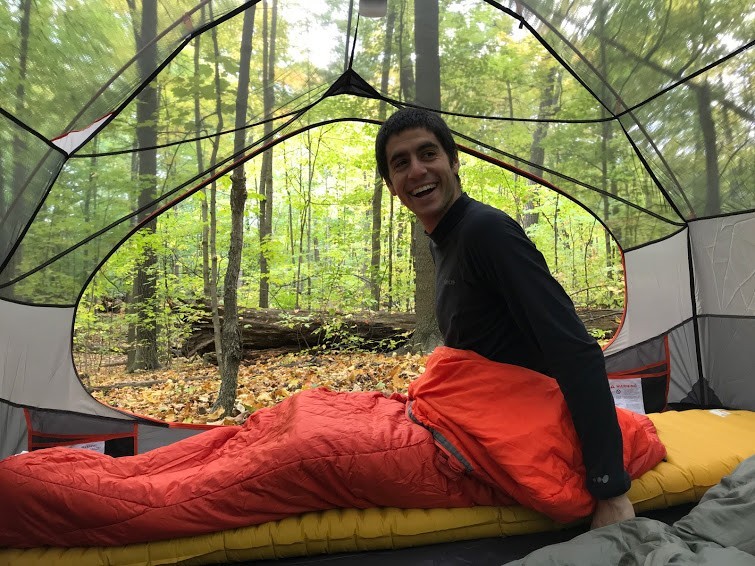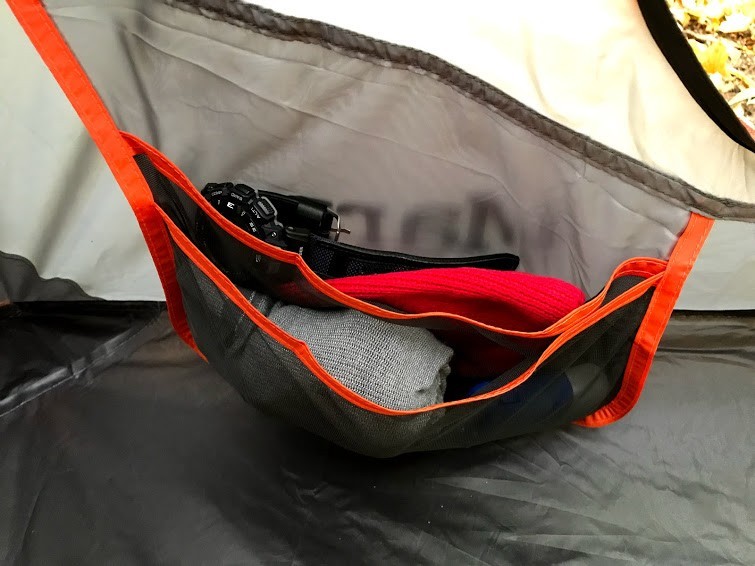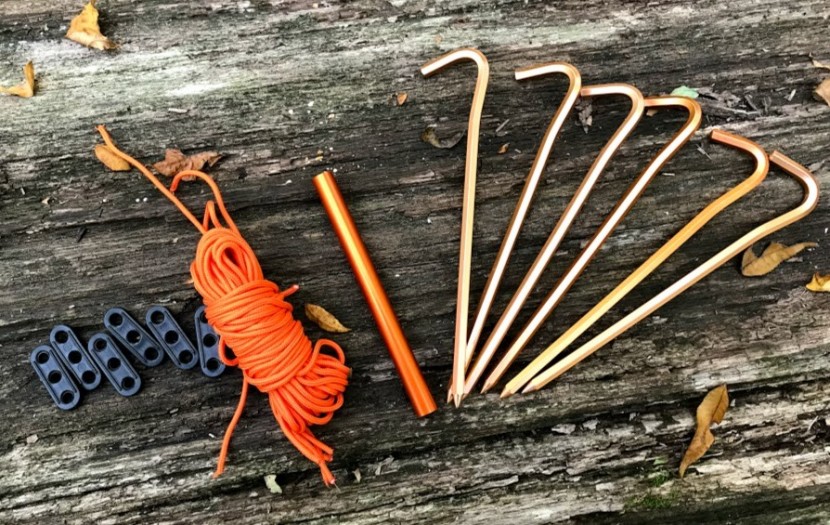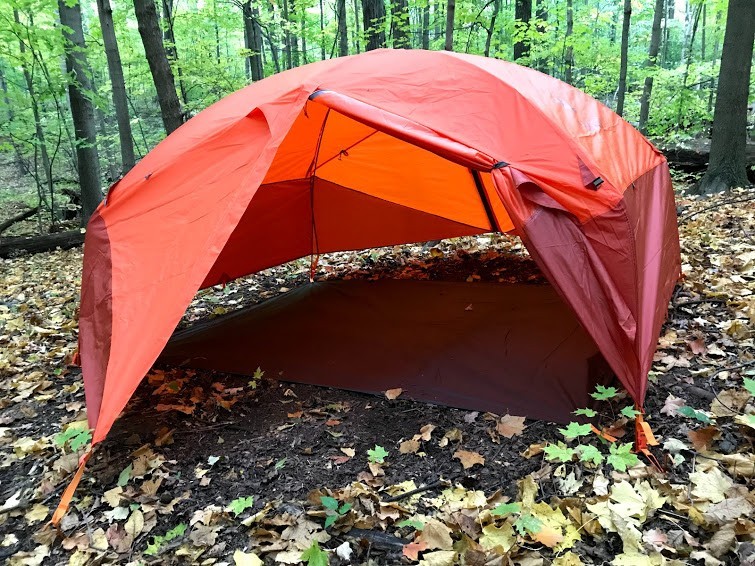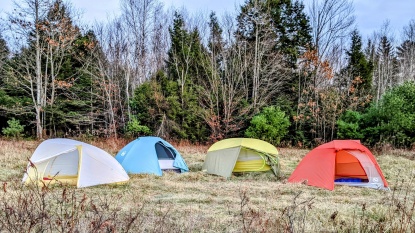Marmot Limelight 2 Review
Our Verdict
Our Analysis and Test Results
We took this tent out in the foliage of fall to see what it could offer. Our weekend adventures were fun, if not a little damp. The Marmot Limelight keeps pace with some of the best regarding comfort and ease-of-setup, but ultimately loses ground for durability, weight, and packed size.
Comfort
This tent offers more comfort than it initially appears. Though on paper, its length is comparable to many other tents in this review, its width and peak height make it stand out from the rest. Two people could easily sit up in it at the same time, something that cannot be said for some ultralight counterparts.
Its fairly unique pre-bent pole structure creates an interior space surrounded by vertical walls, which makes for a greater cross-sectional area higher up than on most tents.
We loved the two massive side doors. They are asymmetrical; one is a D-shape, and the other is a teardrop that opens almost all the way around and tucks away into a pocket at the foot of the door.
There is a large double-layer pocket on each side. At some points, we felt like they could almost hold too much stuff because the weight of the gear and devices they were holding sort of forced them closed at the top. It is also slightly inconvenient that they are at opposed sides of the tent (meaning people have to sleep head-to-toe to be within easy arms reach of their respective pockets).
Ease of Set-up
The Limelight is relatively easy to set-up. It has two long poles that cross at a central hub, as well as a separate cross-pole that expands the headroom. The pre-bent poles can be slightly unwieldy — they like to rotate around the hub as you are sliding the segments together, but this is a minor annoyance.
There is quite a bit of guyline, but not enough for the multiple guy points on the fly. We wouldn't recommend taking this tent out in the kind of weather that would require it, but if you need to, we suggest using the included line first at the loops on the head and foot ends of the fly to pull it away from the tent.
The tent-to-pole and corner tent-to-fly clips seem like cheaper plastic than most of the other tents, but they get the job done. The six hex stakes anchor and stay anchored relatively well.
Weather Resistance
We are pleased with the weather resistance of the Limelight. It keeps the rain out well, and if you guy or stake the head and foot ends of the fly, there is enough separation from the tent that contact with the mesh canopy is not an issue. However, with the fly closed up, the ventilation is poor. The small vent at the top of each vestibule doesn't do the trick, so count on some overnight condensation unless you can roll back the fly partially or completely.
The included footprint is a plus. It attaches to the poles with the grommets at its corners and adds both debris protection as well as an extra barrier against ground moisture.
The single stake at each vestibule means that the fly is susceptible to flapping, and the heavy material sags even more deeply once it gets wet, but as long as we were careful to pitch and stake it well, we are happy to say we didn't have any rain catastrophes.
Durability
The Limelight is made from some hefty 68 Denier poly taffeta. Though it is less elastic than ripstop nylon, the thick material means that it is highly puncture-resistant. Combined with an additional layer of security from the included footprint, with reasonable, regular care, this tent should last a long time.
With that in mind, we could envision the pole hub and fly and tent clips breaking before the material wears through. We have also heard reports of the polyester not standing up well to repeated UV exposure.
Weight and Packed Size
This is a monster of a tent. The two-person version weighs in at 5lbs, 10 oz. The heavier materials, combined with the clunky pole structure, make it feel even bigger. If you're planning on carrying it solo, this tent will take up most of your pack space. Even splitting the weight between multiple people still leaves each one carrying a load that is still heavier than some other entire tents (i.e., you could each carry your own two-person tent, and still be carrying less weight than one Limelight).
On the plus side, this tent includes a footprint, which is highly unusual. What this means is that it is possible to set it up in fast-pitch mode, without the tent body itself, thus reducing the total load by a couple of pounds. The biggest drawback to fast-pitch is significantly reduced bug protection.
Value
For couples primarily car camping, the Limelight 2 is a good value. However, the reality is that its most similar competitors are superior in almost every way, including value.
Conclusion
This tent is great for the budget-conscious camper who likes to spread out. It is large, comfortable, and durable. It's a real whale of a shelter, so we wouldn't want to take it the distance, however short that may be, but for its price, we are pleased with what it offers.
3-Person Version
If you are planning to add in another person, we would recommend sizing up. The Marmot Limelight 3 adds even more space to an already roomy camping experience. We are underwhelmed by the width, adding only 14 more inches over the 2-person (keep in mind that a standard sleeping pad is 20 inches wide). However, it increases the length by a modest, if not significant two inches, and bumps the peak height by a full 5 inches.
However, with the extra room comes the extra weight. At 6.75 lbs, it follows in the footsteps of its two-person counterpart. It is best used in situations that don't require you to carry it anywhere on your back.


